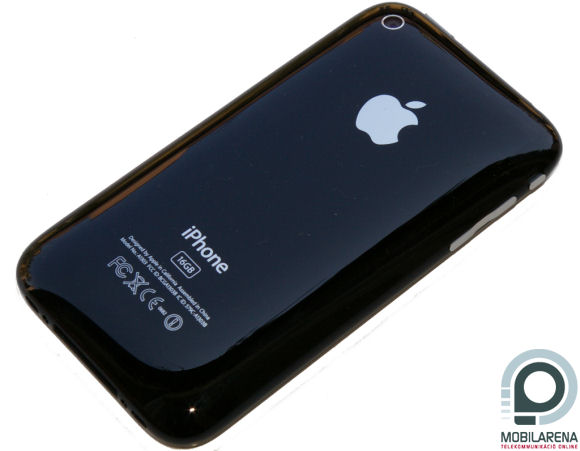Foreword
We’re already used to Apple launching the latest generations of its success products with a very high precision, so it’s no wonder that two years after the first and one year after the second gen iPhone the third one has arrived, which isn’t much different in its name or features from the one year old iPhone 3G. The name of the new handset is 3GS, it has some new hardware and software features, and most of the soft updates are not available only for those who spend some money and buy the latest handset, as the new operating system can be downloaded to previous handsets as well – for free.
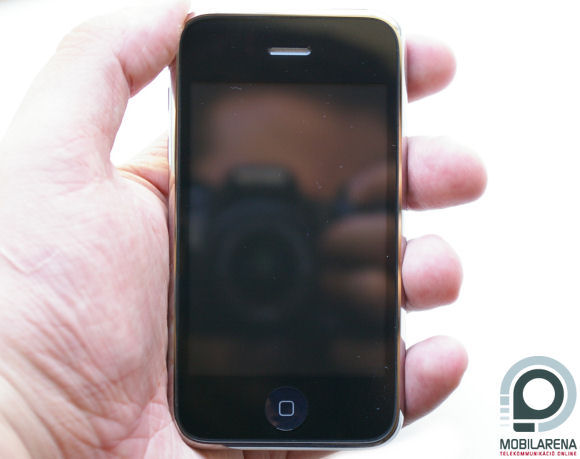
Those who really hate the hype around iPhone have found a great target in iPhone 3GS, as it’s a fact that there aren’t many features that make the device better than its predecessor. But there is one thing that went much better at the launch of the third iPhone than at the second: 3GS arrived to stores in many countries at the time of its launch, even though at a very high price, in SIM-free edition. The reason for this is that iPhone was available in selected countries at the time of launch, and retailers from other regions took on the task of taking back the handset to the country of purchase (eg. Italy) if something goes wrong, as iPhone is one of the few Apple products that comes with no world-wide warranty, so local Apple retailers and services don’t accept them for servicing.
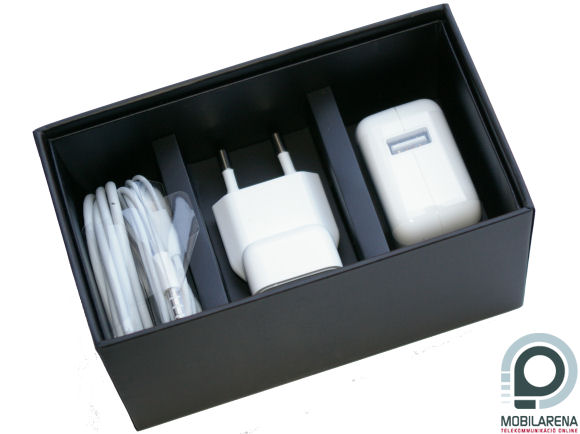
The handset we had for testing was a 16 GB model we received from XXL GSM. The packaging didn’t change at all, the box and the accessories have been inherited from 3G, so besides the phone we’ll get a stereo headset, a charger connector, a data cable and the “needle” used for taking out the SIM socket inside the classy black package.
Hardware changes
There is only a minimal amount of change on the outside, the new iPhone looks just like its predecessor, it only gained some weight, so it now weighs 135 grams. It has a size of 115.5 x 62.1 x 12.3 mm, it’s also available in black and white, but we can notice on the back that the storage capacity has doubled, it increased from 8/16 GB to 16/32 GB. Although it’s not written on the phone, the RAM has also doubled, we now have 256 MB.
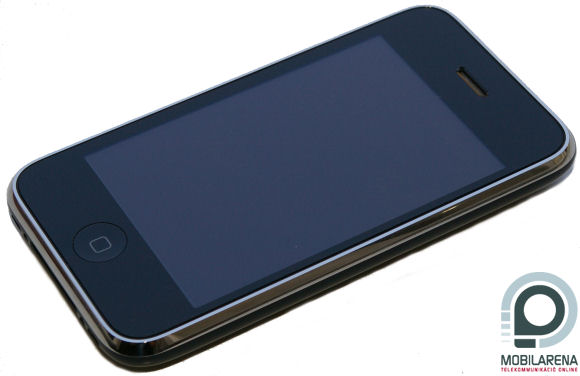
The case is of the same quality, everything is made of shiny plastic (with the exception of the stripe around the front), which is a great fingerprint-magnet, but at least it looks good. The fittings don’t seem perfect, hair or moisture could get stuck in the small hole, which might be a bit annoying, I think this should have been avoided. The display still has a diagonal of 3.5”, a resolution of 320 x 480 pixels, which doesn’t sound too much, but the thing is that besides Samsung’s AMOLED screens, nothing looks as good as iPhone’s.
The main changes have affected the inside: besides doubling storage space and memory, the new iPhone has a new processor and video chip, instead of the 412 MHz ARM11 CPU, it now has a 600 MHz chip, based on a Cortex A8 core, while the PowerVR MBX-Lite graphical chip has been swapped out to a PowerVR SGX – this is the same processor that Palm Pré uses. Although you can’t guess it from its name, introducing the Cortex A8 means a generation leap at ARM architecture chips, as ARM11 represents the sixth generation and A8 is from the seventh gen. This of course means that besides the better clock speed, the Cortex A8 also has better features: while iPhone 2G/3G’s CPU had a simple basic vector floating point unite, Cortex has a more advanced SIMD unit with its own pipeline, advertised under the brand name NEON – this pipeline has 10 stages, while the main integer pipeline has 13. SIMD stands for single instruction multiple data, processing units based on this technology can apply an instruction to multiple units of data at the same time, which comes in handy at graphical tasks and multimedia. Cortex A8 has two times as much double-precision floating point number registers, while L1 cache size increased from 2 x 16 kB to 2 x 32 kB and it also has 256 kB of L2 cache. Otherwise A8 is a superscalar core, it has two ALU’s that can execute two independent instructions, but it doesn’t support out-of-order instructions. This means that it can read, decode and execute two RISC instructions (it supports multitasking), but it can process these instructions in order. On the whole we can say that Cortex A8 is the most advanced CPU we can find in mobile phones nowadays.
| CPU | iPhone 2G/3G | iPhone 3GS |
| Type | Samsung S3C6400 | Samsung S5PC100 |
| Architecture | ARM11 | ARM Cortex A8 |
| Instruction execution | in-order | in-order |
| Integer pipeline | 8 stages | 13 stages |
| Clock speed | 412 MHz | 600 MHz |
| L1 cache size | 16 kB I-Cache + 16 kB D-Cache | 32 kB I-Cache + 32 kB D-Cache |
| L2 cache size | none | 256 kB |
The graphical core is also from a new generation, SGX is from the fifth, while MBX Lite was from the fourth PowerVR generation – I’d like to note that the first was used in Kyro PC graphical cards, while the second has been featured in the Sega Dreamcast game console. There are more types of SGX, the most basic is SGX520 and the most powerful is SGX540. There were rumors before the launch of the new iPhone that the handset will feature the 520 edition, which is although the weakest from the series (it has a single 200 MHz USSE pipe), it can render 7 million polygons and 250 million pixels per second, which is seven times as much in geometrical speed and it has a three and a half times faster fill rate than the MBX Lite in iPhone 3G. The truth is even better, as according to officially unconfirmed information, iPHone 3GS has the SGX535 chip, which can pump out 28 million polygons per second – Palm Pré has SGX530 that has a speed of 14 million polygons/second. If we also consider OpenGL ES 2.0 support we can say that the new hardware turned the new iPhone into a real gaming platform, although it wasn’t bad already.
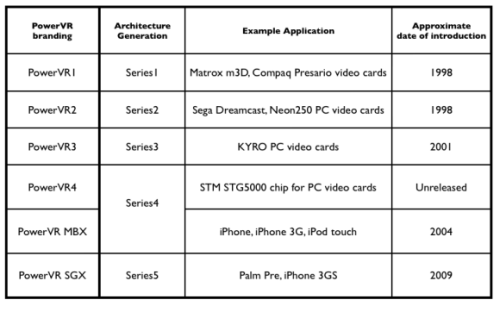
PowerVR graphical chip generations
New features of iPhone OS 3.0
With the launch of the handset, Apple also released the 3.0 software, which can be downloaded for earlier hadnsets as well (iPhone 2G/3G, iPod Touch 1G/2G), so even those get most of the new features, although not all of them. First let’s see which are available for all devices.
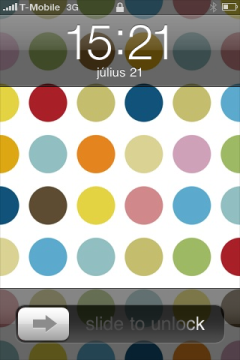
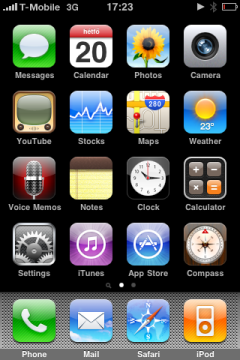
One of the most important new features is that we can finally select, copy, cut and paste texts. There are two methods for selection, both of them are very simple. If we tap and hold a text in order to move the cursor and make the magnifying glass appear, after releasing we get to see the select, select all, and paste functions. If we opt for the first one, we will be able to move the start and end of selection markers. If we want to select a single word, we just have to double-tap it – we will still be able to move the markers.
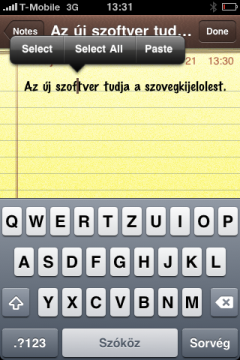
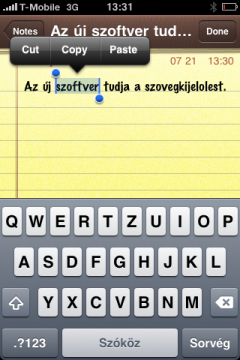
Another important thing is that the new software has a sound recorder, which allows us to record sound clips of any length – this is of course not available on iPod Touch 1G, as that has no microphone. The third new feature is available only for iPhone 3G and 3GS: MMS. The new software finally allows the user to send or receive multimedia messages, the images are nicely displayed in the usual SMS window, but of course we can send sound clips as well. If we’re already at images and messaging, I’d like to note that the new software finally allows us to attach multiple images to emails and SMS/MMS deletion has been improved as we can delete them one by one, there’s no need to erase the whole thread.
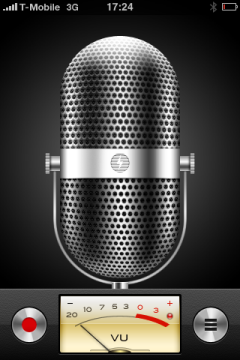
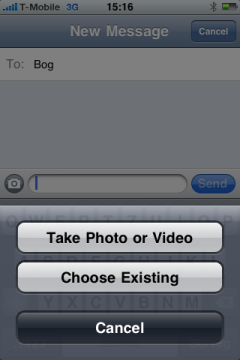
The SpotLight search is available on all devices, it’s on the left of the first page of the main menu. It’s a text search that searches in all information on the phone, including music, messages, mails, contact list – we can of course select the locations where to search, by default it’s enabled everywhere.
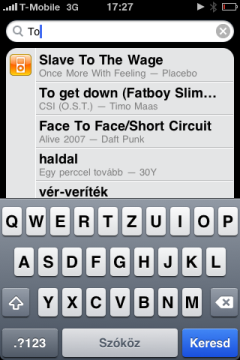
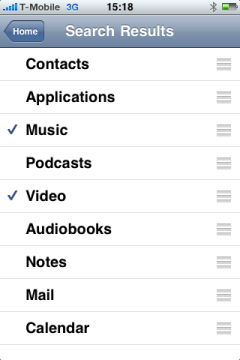
Tethering, internet connection sharing, could be the most important improvement, which means that from now on we can use the iPhone as a modem if we’d like to browse the web from our notebook. We can connect the handset to a computer via Bluetooth or cable, but the wireless connection could make the battery go dry really fast, as Bluetooth and 3G will be turned on simultaneously. Theoretically it’s extremely easy to turn this service on, we just have to enable it in the settings – but it first has to be activated.
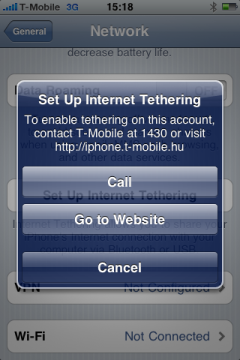
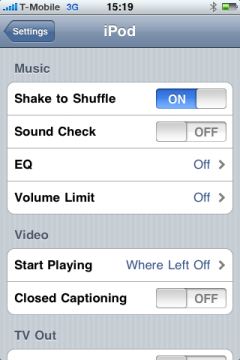
Apple also introduced shake control, which was quite logical, as this feature has been present on the third generation iPod nano. We can use this at two places: after turning on shake to shuffle we can skip a track in the music player – of course only inside the current playlist, so if we select an album from a given artist, shaking will skip to another track on the same album. When entering text we can undo everything by shaking, but of course the software will ask us first if we want to do this, thus avoiding the automatic deletion of many lines of text for example.
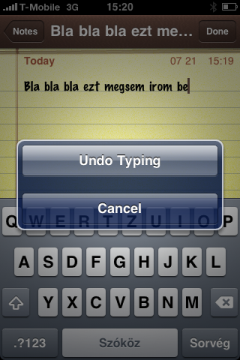
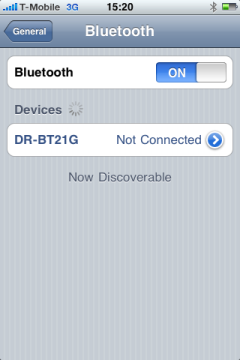
Although there are hundreds of small new features, I’d like to note only three more. One of them is that Bluetooth has been improved, and although it still can’t be used for sending files, it lets us connect stereo headsets – this feature has appeared on iPod Touch 2G as well, as due to Nike+iPod that has Bluetooth too. It’s also important that the Safari web browser allows us to automatically fill in some web forms, which means that the program can remember our login credentials at websites (user name and password), so we don’t have to type them every time. The last of the best new features is not in the software itself, but in the AppStore philosophy: Apple has finally allowed developers to create GPS-based navigation software for the handset.
New software features of 3GS
The manufacturer has of course been careful to provide some new features only on the new 3GS, as otherwise there would have been much less people to buy a new device only for the faster CPU – let’s just say that these exclusive new features might still not be enough to draw hundreds of thousands of people to the stores to get the new phone.
Why? Because there are surprisingly few features that are available on the new handset, but cannot be used on the old one. One of these is the digital compass, which looks really impressive, I have no idea how it works, it immediately shows the real/magnetic north after launch (we can set which one should be shown) and it displays our coordinates, even when inside a building.
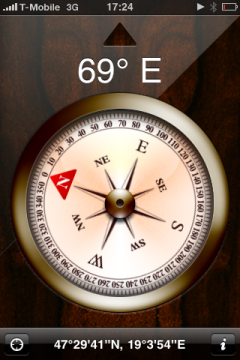
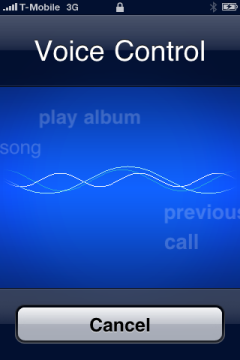
Another bonus is voice recognition, which lets us start calls and control the music player – this will surely be a favorite one of those who have a headset. The voice recognition software doesn’t support many languages, so it could be a problematic one if we’re not native speakers of English and have non-English names in our contact list. Music playback control is ok, I think anyone can pronounce “play” and “shuffle”.
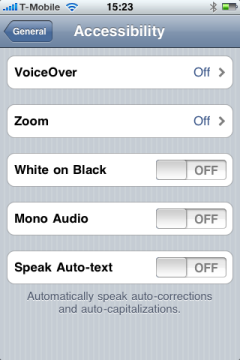
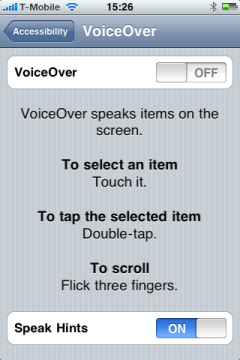
The third new feature could be the most useful one, as it helps handicapped people use the phone: we’re talking about zooming and text narration, text highlighting and mono sound. The first two are the more important ones, we can use only one of them at a time. Zooming is very simple, we have to double-tap the screen with three fingers to zoom in any part of the screen. We can zoom in to really any part, even the main menu, all features will be active, but of course we’ll have to scroll the screen, which is also done with three fingers. Narration is also great, if we turn it on, iPhone will read aloud the selected part with a great pronunciation, but it might be a bit fast. As we turn this feature on a marker will appear, we can place this anywhere we want with a tap, and all simple taps from now on have to be replaced with a double, so we have to work this way to launch programs/press buttons. The software can read any information on the screen, even text messages. I’d like to note that the narration algorithm is much, much better than the one on the Nokia Series 60 handsets.
The phone is of course faster than its predecessor, this is quite evident. We’ll mostly feel this when launching resource-hungry games and when browsing the web, as iPhone loads web pages about twice as fast as the simple 3G. This is also true when launching games, but we won’t feel much difference at system apps, for example the e-mail client launches in less than a second, this takes about half a second longer on 3G.
Phone calls, data transfer, internet
Basically nothing has changed during phone calls, voice quality is perfect, if we use a headset we can select when starting a call if we want to use iPhone’s speaker or the handsfree’s. The contact list still has an unlimited capacity, there are lots of extra fields, and I have already mentioned messaging. I’d like to note about the email client that besides images it can also accept and handle Microsoft Office documents (Word, Excel, PowerPoint) and Adobe PDF files and it’s also compatible with Microsoft Exchange servers. About synchronization: we can also sync notes with iTunes.

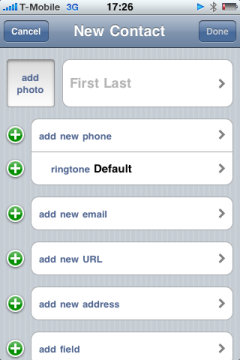
As for data transfer, there aren’t many improvements: HSDPA now works on 7.2 Mbps instead of 3.6. If there’s no coverage at our place we can use plain UMTS, EDGE and GPRS as well, and if there’s no signal at all, we can use a WiFi network. Using wireless LAN the battery takes twice as much to go dead, so we should use that if possible.
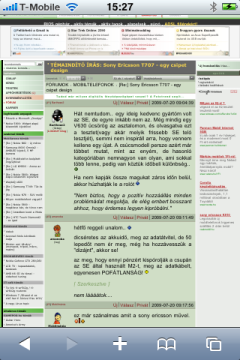

iPhone is still the king of web browsing and all the stuff that’s related to it. Safari is even faster, it loads pages at an incredible speed, it’s very easy to use and it’s even fast, so all hail to the developers! The handset has native YouTube and Google Maps clients, this latter one has Street View support as well. We can download a native Facebook client from the AppStore for free, and not just that: we can obtain almost anything from the virtual store that has tens of thousands of applications.
Multimedia
The camera has a resolution of 3.2 megapixels, it features autofocus and can take pictures at a resolution of 2048 x 1536 pixels at most, but the software has no settings at all. Focusing is simple, the phone does it automatically before shooting, so it does it again and again if we move the phone. We can record videos as well with 3GS at a resolution of 640 x 480 pixels, the speed being 30 frames/second. You can check out a test video right here.
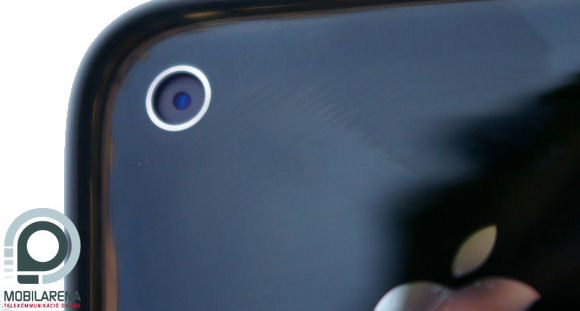
Image quality is average, iPhone’s pictures are still far from the quality of the rivals’ – and that’s the least to say. Noise level is rather high, the automatism misses a lot of times, and we can barely take any picture with correct exposure: most pictures are a bit over- or under-exposed. Edge sharpness is good, the colors are not very bright and not very pale, dynamics range is medium and there’s no chromatic aberration.
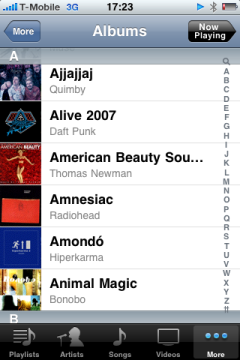
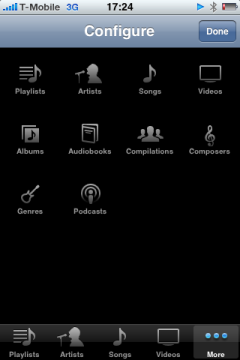
iPhone is still great in music, but it still has two problems: it doesn’t have an FM radio and we can’t create our own presets on the equalizer. It’s great fun to browse our music if we fill out their ID3 tags in iTunes.

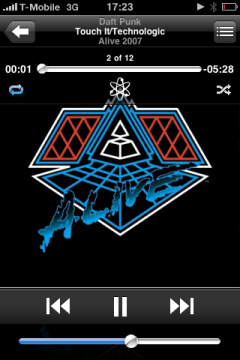
The software has one new feature, this is related to seeking: if we grab the seek slider, we can seek in the track by pushing it, but if we move our finger down and start pushing the slider there, we can seek at a much lower rate. This is useful for those who are listening to a couple of hours long mixes on their phone, from now on they can also seek with a precision of a couple of seconds.
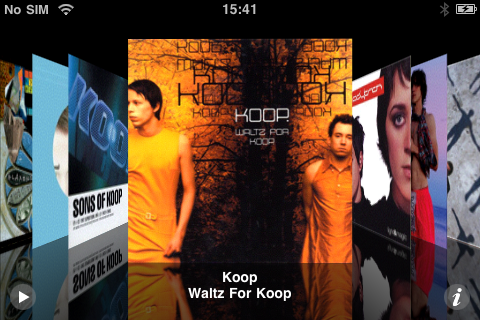
I think the handsfree speaker is somewhat better than on the predecessor, but as I have no simple 3G at my disposal, I’m not sure about it. The headset is the same, I like it because it’s comfortable, but those who have a better musical hearing are criticizing its quality quite a lot of times. As opposed to the first iPhone, we can use any kind of headset with the 3GS, the 3.5 mm headset jack is not sunk, so we can plug in even the largest connector. The jack also has TV-out, we can review our videos on a TV if we get the proper cable.
GPS, battery, summary
Currently, besides Navigon, we have Sygic’s Mobile Maps Europe and iGO available for the iPhone (TomTom is coming soon as well), so I’ve tried Navigon’s solution. The handset can be used for navigation for about 2-3 hours when fully charged, which isn’t very much, but in turn Mobile Maps Europe is available in many languages. The software has a couple of unique features, for example it tells us on arrival whether the target is on the left or right side of the road, and when planning the route it offers us to look for parking near the target – it also has some flaws, for example it exits when accepting a call during navigation, but it won’t save the current route. The map software is not the best one (it’s from TeleAtlas), but it’s not a bad thing at all. The program works in landscape and portrait mode as well, and the one that has the full Europe map costs 80 euros.
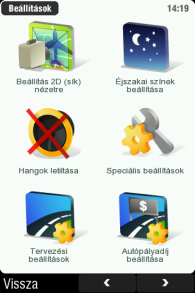
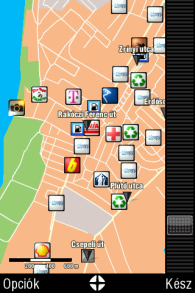
The demo version of Sygic Mobile Maps Europe
Battery time improved a lot, we can talk for 12 hours on 2G and for 5 hours on 3G, standby time is 300 hours according to official data. We can browse the web for 9 hour on WiFi and for 5 hours on 3G, music playback is about 30 hours, video playback is 10. As I didn’t have a chance to test the phone for weeks, I can’t confirm or infirm this information, the tendency shows that the battery times published by Apple are quite realistic, although, just like every manufacturer, they also tell somewhat more.

With this paragraph we’ll probably turn ourselves into a target, but the fact is that most of us at MobileArsenal like the iPhone very much, although we really had every possible phone for testing. We don’t say that this is the only correct way to do it, but the thing is that with the new software and the new hardware the handset made a great leap towards perfection. The powerful hardware converts the otherwise great iPhone into a gaming platform, I can hardly wait for the first 3GS-exclusive gaming titles to be announced, they will probably be much better than their PSP counterparts. If we take a look at iPhone’s software we won’t have much to complain about. It’s true that it’s a joke that we had to wait so much for features like the MMS or one-by-one SMS deletion, but they are finally here, so it’s quite useless to rant about the past. Of course there are still some flaws remaining, for example file sending via Bluetooth or that we have to use iTunes to sync the handset, even though I like this one, no matter that it hurts the feelings of many people when a manufacturer forces the users to use their own software, Apple’s application is better than any other manufacturer’s.
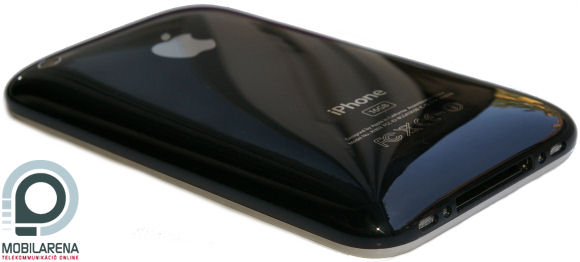
Is it worth switching to iPhone 3GS as an average user? Not really, the digital compass, voice recognition and accessibility features don’t mean such an attractive feature set that would require a change, and the other new features are available for the simple 3G as well. If we consider the iPhone as a gaming console than it might be worth it in a couple of months, as it will probably have even better apps later on. Although the handset is incredibly expensive – we have to pay nearly 1,100 euros for the 32 GB edition – I still give a Recommended award, as it gives everything for average users and it costs about 660 euros with legal unlocking. I would be happy to use this handset – the last time I told this was at the Android.
 |
| Apple iPhone 3GS |
Bocha
Translated by Szaszati
iPhone 3GS has been provided by XXL GSM. The handset can be purchased at:
Budapest VI. Jókai tér 6.
Budapest VI. Teréz körút 18.
On-line at www.xxlgsm.hu.
Specifications
| Apple iPhone 3GS | ||
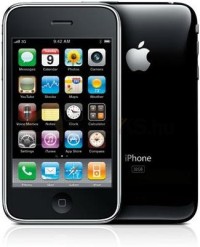 |
General | |
| Technology | GSM, UMTS | |
| Size | 115.5 x 62.1 x 12.3 mm | |
| Weight | 135 grams | |
| Available colors | black, white | |
| Display | ||
| Display diagonal | 3.5” | |
| Display resolution | 320 x 480 pixels | |
| Display type | TFT | |
| Number of colors | 16.7 million | |
| Memory | ||
| Phonebook capacity | dynamic | |
| SMS memory / max. MMS size | dynamic / scalable | |
| Internal memory | 16/32 GB | |
| RAM size | 256 MB | |
| Memory expandability | not expandable | |
| Data transfer | ||
| Frequency bands | 850/900/1800/1900 MHz | |
| GPRS / EDGE | yes / yes | |
| UMTS / HSDPA / HSUPA | yes / yes (7,2 Mbps) / no | |
| IrDA / Bluetooth | no / 2.1 (headset only) | |
| WiFi | yes | |
| USB | Proprietary connector (2.0) | |
| Push-to-talk / RSS | no / no | |
| GPS receiver | yes (A-GPS supported) | |
| Basic functions | ||
| Profiles | no | |
| Vibra function | yes | |
| Built-in handsfree | yes | |
| Voice dialing / voice commands | yes / yes | |
| Sound recorder | yes | |
| Alarm clock | yes, also when turned off | |
| Predictive text entry | yes | |
| Software | ||
| Platform | iPhone OS | |
| WAP / HTML browser | yes / yes | |
| E-mail client | yes (POP3, IMAP4, authenticated) | |
| Java | no | |
| Games | none by default | |
| Currency converter | no | |
| Extra software | Google Maps, scientific calculator, digital compass, stocks application, weather forecast, Application Store and iTunes Music Store | |
| Multimedia | ||
| Main camera | 3.2 megapixels, autofocus | |
| Secondary camera | no | |
| Video recording | yes (VGA resolution) | |
| Music player | yes, can run in background | |
| Equalizer | yes | |
| FM radio | no | |
| Battery | ||
| Main battery | unknown capacity, cannot be changed | |
| Standby time | 300 hours | |
| Talk time | 5 hours (3G) / 12 hours (2G) | |
| Web browsing time | 5 hours (3G) / 9 hours (WiFi) | |
| Music playback time | 30 hours | |
| Video playback time | 10 hours | |
| Others | ||
| gyroscope, multi-touch touchscreen, 600 MHz ARM Cortex A8 CPU | ||
